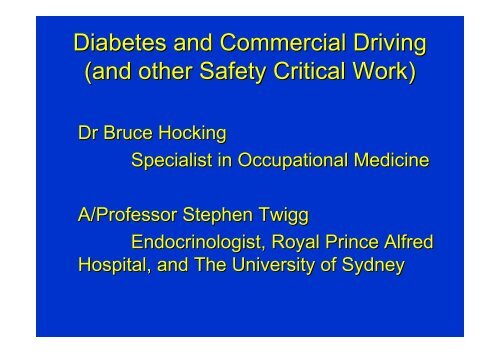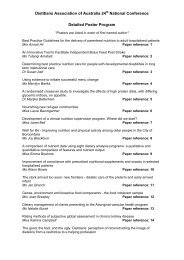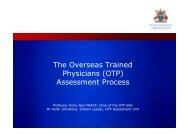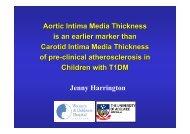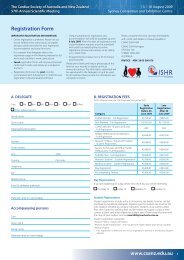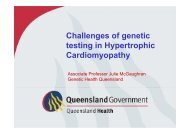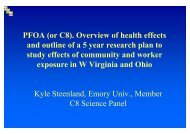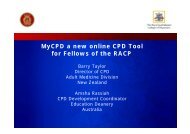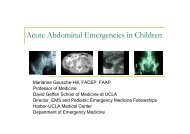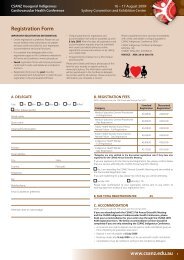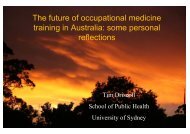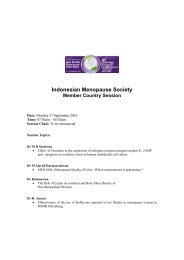Diabetes and Commercial Driving (and other Safety Critical Work)
Diabetes and Commercial Driving (and other Safety Critical Work)
Diabetes and Commercial Driving (and other Safety Critical Work)
Create successful ePaper yourself
Turn your PDF publications into a flip-book with our unique Google optimized e-Paper software.
<strong>Diabetes</strong> <strong>and</strong> <strong>Commercial</strong> <strong>Driving</strong><br />
(<strong>and</strong> <strong>other</strong> <strong>Safety</strong> <strong>Critical</strong> <strong>Work</strong>)<br />
Dr Bruce Hocking<br />
Specialist in Occupational Medicine<br />
A/Professor Stephen Twigg<br />
Endocrinologist, Royal Prince Alfred<br />
Hospital, <strong>and</strong> The University of Sydney
<strong>Diabetes</strong> <strong>and</strong> <strong>Commercial</strong> <strong>Driving</strong><br />
(<strong>and</strong> <strong>other</strong> <strong>Safety</strong> <strong>Critical</strong> <strong>Work</strong>)<br />
Aims<br />
• To introduce concepts of medical<br />
st<strong>and</strong>ards for <strong>Safety</strong> <strong>Critical</strong> <strong>Work</strong>.<br />
• To familiarise usage of Assessing Fitness<br />
To Drive when examining commercial<br />
drivers with diabetes.
Kempsey 1989 – 35 dead<br />
- no skid marks - sleep?
Coroners cases - Bednarek SA (2001)<br />
• Shantel Bednarek died in 1999 after being struck by a<br />
car driven by a person with diabetes, Mr Greg<br />
Johnson, during a hypoglycaemic episode (blood<br />
glucose level, 3.0 mmol/L).<br />
• He had poorly controlled insulin dependent (type 1)<br />
diabetes <strong>and</strong> “hypoglycaemic unawareness”. Mr<br />
Johnson worked as a car salesman (!) <strong>and</strong> had one<br />
episode of hypoglycaemia at work, for which he<br />
required admission to hospital.<br />
• Johnson was seen by various doctors who gave<br />
varying advice regarding driving so Johnson was able<br />
to claim that he had never been properly told that he<br />
could not drive.<br />
• There is a need for doctors to be clear when advising<br />
patients not to drive <strong>and</strong> to document this clearly in<br />
their records.
Coroners cases. Sheriff Vic.(2005)<br />
• Mr Sheriff was a road worker who was killed by<br />
a truck driven by a man with diabetes, Mr Glenn<br />
Robertson, during an episode of hypoglycaemia<br />
(December 2002).<br />
• The Coroner recommended that the guidelines<br />
for medical examiners in relation to <strong>Commercial</strong><br />
Vehicle Drivers be reviewed <strong>and</strong> the criteria for<br />
driving in respect of type 1 diabetes ought to be<br />
more stringent such that applicants who require<br />
insulin therapy shall not be entitled to hold<br />
commercial or passenger carrying vehicle<br />
licences unless certain criteria are satisfied
Bus driving
DG (petrol) tanker driving
Road Train <strong>Driving</strong>
Emergency Services<br />
- not all police drive pursuit!
Fork lift driving can be hazardous<br />
to the driver <strong>and</strong> <strong>other</strong>s
Train Driver (solo)
Waterfall train disaster – 7dead- VF<br />
Legal rulings re medical examination
Maritime Pilots<br />
- huge forces in a confined space
Setting medical st<strong>and</strong>ards for<br />
<strong>Safety</strong> <strong>Critical</strong> <strong>Work</strong><br />
The Medico-legal environment<br />
• Duties of care<br />
• EEO<br />
• Privacy
Medico-legal context of st<strong>and</strong>ards.<br />
Medical st<strong>and</strong>ards sit in 3D legal space.<br />
Disability<br />
Discrimination<br />
Medical<br />
st<strong>and</strong>ards<br />
Privacy<br />
Duties of care.<br />
(OHS, public<br />
liability, envt)
Development of health assessment st<strong>and</strong>ards begins<br />
with defining the inherent requirements then<br />
identifying the necessary health attributes <strong>and</strong> finally<br />
setting the medical criteria. <strong>Diabetes</strong> has multiple<br />
potential effects (vision. cardiac, hypoglycaemia).<br />
Inherent<br />
requirements<br />
Define nature<br />
of task<br />
Health attributes<br />
Define health<br />
attributes linked to<br />
inherent<br />
requirements<br />
-Senses,<br />
-M/Sk,<br />
-Cognitive,<br />
-General Health<br />
(acute incapacity)<br />
Health<br />
assessment<br />
& medical criteria<br />
Define the tests<br />
required to<br />
measure<br />
health status in<br />
relation to the<br />
health<br />
attributes <strong>and</strong><br />
criteria to judge<br />
fitness for duty
<strong>Diabetes</strong> – Medical Criteria<br />
5.1 RELEVANCE TO DRIVING TASK<br />
<strong>Diabetes</strong> may affect a person’s ability to drive due to:<br />
• Loss of concentration or consciousness in a<br />
hypoglycaemic episode, or<br />
end organ effects relevant to driving:<br />
• Vision (fields, acuity)<br />
• Ischaemic heart disease<br />
• Peripheral nerves <strong>and</strong> vasculature of the extremities,<br />
particularly the feet.
Risk Stratification of <strong>Diabetes</strong> <strong>and</strong><br />
<strong>Driving</strong><br />
Private<br />
Vehicle<br />
<strong>Commercial</strong><br />
Vehicle<br />
(may subdivide<br />
DG & Buses)<br />
Type 1 ---------------------<br />
---------------------<br />
---------------------<br />
Type 2 ---------------------<br />
---------------------<br />
---------------------
<strong>Diabetes</strong> – Medical Criteria - Vision<br />
Acuity<br />
• Private vehicle<br />
The criteria for an unconditional licence are NOT met:<br />
– If the person's visual acuity in the better eye or with both<br />
eyes together is worse than 6/12.<br />
• <strong>Commercial</strong> Vehicle.<br />
The criteria for an unconditional licence are NOT met:<br />
– If the person's visual acuity is worse than 6/9 in the better<br />
eye; or<br />
– If the person's visual acuity is worse than 6/18 in either eye.<br />
• A conditional licence may be granted by the Driver<br />
Licensing Authority……………………,
<strong>Diabetes</strong> – Medical Criteria - Vision<br />
Visual Fields (eg laser surgery)<br />
• <strong>Commercial</strong> vehicle<br />
The criteria for an unconditional licence<br />
are NOT met:<br />
- If the person has any visual field<br />
defect.<br />
• A conditional licence may be granted by<br />
the<br />
Driver Licensing Authority,……………….
Fundus photo showing scatter laser<br />
surgery for diabetic retinopathy
<strong>Diabetes</strong> – Medical Criteria - Cardiac<br />
Angina<br />
• <strong>Commercial</strong> Vehicle<br />
• The criteria for an unconditional licence are NOT<br />
met:<br />
- If the person is subject to angina pectoris.<br />
• A conditional licence may be granted by the<br />
Driver Licensing Authority,……………..<br />
- treadmill test, angiogram, etc.<br />
- noting <strong>other</strong> risk factors eg diabetes.
Clinical Case #1<br />
• New patient: 35yrs male Type 1 diabetes<br />
diagnosed 3 months ago<br />
• <strong>Commercial</strong> truck driver from Griffith<br />
• Heavy rigid vehicle<br />
• Overnight shifts<br />
• Recently commenced on twice daily<br />
Mixtard 30/70, 20 units bid s.c.<br />
• One episode of severe nocturnal<br />
hypoglycaemia 1 month previous
Clinical Case #1<br />
• What <strong>other</strong> information (medical,<br />
occupational, etc) would you like to know?
Clinical Case #1<br />
• What medical concerns do you have?
Clinical Case #1<br />
• OP. What advice would you provide to him <strong>and</strong><br />
the employer regarding fitness for duty?<br />
• Endocrinologist: He asks for a certificate for the<br />
Driver Licensing Authority in support of renewal<br />
of his licence. What do you write?
Clinical Case #2<br />
• 25 year old female, Type 1 diabetes, 15 years duration<br />
• Enjoys driving, completing a TAFE Course in computer<br />
science, but wants to commence as a full time bus<br />
driver<br />
• Bus driving in metro Sydney, involves shift work.<br />
• Had one episode of hypoglycaemia after a few alcoholic<br />
drinks at her 18 th birthday party<br />
• On Lantus once daily <strong>and</strong> Novorapid with each main<br />
meal, tds<br />
• No microalbuminuria<br />
• Vision (acuity, fields) OK, fundus shows early<br />
maculopathy.<br />
• No peripheral neuropathy<br />
• No history of macrovascular disease
Clinical Case #2<br />
• What further information would you like to<br />
know?
Clinical Case #2<br />
• OP. What advice would you provide to the<br />
employer regarding fitness for duty?<br />
Justify it. If she were accepted for<br />
employment what advice would you give<br />
her?<br />
• Endocrinologist: She asks for a certificate<br />
in support of her licence for the Driver<br />
Licensing Authority. What do you write?
Clinical Case #2<br />
• If she became pregnant how would you<br />
manage her ?
Clinical Case #3<br />
• 54 year old male, Type 2 diabetes, 11 years<br />
duration, commercial truck driver<br />
• Drives semi-trailer, interstate overnight.<br />
• Needs to commence insulin due to secondary<br />
failure: HbA 1C 10.4%<br />
• No albuminuria<br />
• Diabetic maculopathy – past laser treatment<br />
• No history of macrovascular disease<br />
• Dense peripheral neuropathy with Charcot’s<br />
arthropathy of left foot recently diagnosed
Clinical Case #3<br />
• BP 130-138/85-94 mmHg<br />
• LDL-C 2.1 mM on Simvastatin<br />
• Alcohol intake 20-40 g nocte
Clinical Case #3<br />
• What further information would you like to<br />
know?
Clinical Case #3<br />
• OP. What advice would you provide to him<br />
<strong>and</strong> the employer regarding fitness for<br />
duty?<br />
• Endocrinologist: He asks for a certificate<br />
for the Driver Licensing Authority in<br />
support of renewal of his licence. What do<br />
you write?
ADS <strong>Work</strong>ing Party<br />
• ADS is preparing a position statement on<br />
“<strong>Diabetes</strong> <strong>and</strong> <strong>Driving</strong>”.<br />
- Co-Chairs: Chairs: Professor Kamp <strong>and</strong> Professor Twigg<br />
- Systematic review of international guidelines,<br />
coroner’s s cases <strong>and</strong> published literature<br />
- Summary supplementary guidelines for clinical care<br />
• Professional education <strong>and</strong> support materials<br />
• Patient education <strong>and</strong> support materials
ADS WP: Patient Education<br />
• Develop patient education materials.<br />
– Diverse effects of diabetes on driving<br />
– Legal issues re licensing<br />
– Treating doctors role<br />
– Help (web sites, etc.)<br />
• Marketing via multiple channels<br />
– National <strong>Diabetes</strong> Services Scheme<br />
• Views of ADEA <strong>and</strong> DA to be sought.
Questions <strong>and</strong> Discussion
<strong>Diabetes</strong> <strong>and</strong> <strong>Commercial</strong> <strong>Driving</strong><br />
(<strong>and</strong> <strong>other</strong> <strong>Safety</strong> <strong>Critical</strong> <strong>Work</strong>)<br />
Learning Aims<br />
• To introduce concepts of medical<br />
st<strong>and</strong>ards for <strong>Safety</strong> <strong>Critical</strong> <strong>Work</strong>.<br />
• To familiarise usage of Assessing Fitness<br />
To Drive when examining diabetic<br />
commercial drivers.
<strong>Diabetes</strong> <strong>and</strong> <strong>Driving</strong><br />
– some international evidence<br />
• No definite overall increased risk of<br />
accidents overall<br />
• <strong>Diabetes</strong> high risk sub-groups for<br />
accidents:<br />
– type 1 diabetes<br />
– the elderly<br />
– history predicts the future<br />
• Best methods to prevent accidents in<br />
people with diabetes?
<strong>Diabetes</strong> <strong>and</strong> <strong>Driving</strong>:<br />
Some Recent Publications<br />
• Lonnen KF etal., Diabet Med. 2008 May;25(5):578-84. Road traffic accidents <strong>and</strong> diabetes:<br />
insulin use does not determine risk. [UK]<br />
• Hayashino Y etal. Exp Clin Endocrinol <strong>Diabetes</strong>. 2008 Jan;116(1):1-5. Epub 2007 Oct 31.<br />
Relationship between diabetes mellitus <strong>and</strong> excessive sleepiness during driving. [Japan]<br />
• Stork AD, etal. <strong>Diabetes</strong> Care. 2007;30(11):2822-6. The decision not to drive during<br />
hypoglycemia in patients with type 1 <strong>and</strong> type 2 diabetes according to hypoglycemia<br />
awareness. [Netherl<strong>and</strong>s]<br />
• Songer TJ, Dorsey RR. Annu Proc Assoc Adv Automot Med. 2006;50:335-351‘High risk<br />
characteristics for motor vehicle crashes in persons with diabetes by age’; ‘Severe<br />
hypoglycemia was consistently <strong>and</strong> strongly related to crashes at all ages.’<br />
• Diamond TH, Collins J, Rohl P. Aust Fam Physician. 2005;34(3):151-4. Motor vehicle<br />
accidents during episodes of hypoglycaemia - 5 case reports <strong>and</strong> lessons to be learnt. [Aust]<br />
• Szlyk JPetal., Relationship of retinal structural <strong>and</strong> clinical vision parameters to driving<br />
performance of diabetic retinopathy patients. J Rehabil Res Dev. 2004;41(3A):347-58.<br />
• Graveling AJ etal., Hypoglycaemia <strong>and</strong> driving in people with insulin-treated diabetes:<br />
adherence to recommendations for avoidance. Diabet Med. 2004 Sep;21(9):1014-9.
Stork ADM, van Haeften TW, Veneman TF:<br />
<strong>Diabetes</strong> <strong>and</strong> <strong>Driving</strong> (Review).<br />
<strong>Diabetes</strong> Care 29:1942–1949, 2006<br />
• ‘Evaluation of the available research on diabetes <strong>and</strong> driving is difficult.<br />
• Most older studies have either found no association between diabetes<br />
<strong>and</strong> traffic accidents or a small, usually not statistically significant,<br />
increase of the relative risk.<br />
• More recent U.S. research, however, indicated a clear trend, frequently<br />
statistically significant, toward a slightly increased risk of road traffic<br />
accidents in diabetic drivers. The increase of the relative risk in some<br />
studies was only found in specific subgroups of diabetic patients, not<br />
consistent throughout various studies.<br />
• Overall, the available studies indicate that road traffic accidents directly<br />
caused by diabetes seem to be relatively rare occurrences.<br />
• Without doubt, hypoglycemia during driving does occur <strong>and</strong> can cause<br />
traffic accidents.<br />
• If any trend can be distilled, current knowledge may point toward a slightly<br />
increased risk of road traffic accidents for drivers with diabetes. However,<br />
no subgroup that is particularly at risk has been unequivocally defined.’
Stork ADM, van Haeften TW, Veneman TF:<br />
<strong>Diabetes</strong> <strong>and</strong> <strong>Driving</strong> (Review).<br />
<strong>Diabetes</strong> Care 29:1942–1949, 2006<br />
• ‘Taken together, although various studies find an increased<br />
accident rate among diabetic subjects, <strong>other</strong> studies do not<br />
or even show a lower rate. Some studies had relatively<br />
small numbers of diabetic patients. The most<br />
methodologically accurate studies on drivers aged >65<br />
years indicates that there might be specific subgroups of<br />
diabetic patients that are at increased risk.’<br />
• ‘Studies clearly indicate that an increased risk for (a subset<br />
of) diabetic truck drivers could very well exist.’<br />
• ‘Koepsell et al. (diabetes in the elderly) found a 2.6-fold<br />
increase in injury risk for diabetic drivers, which was even<br />
higher (OR 5.8) for patients treated with insulin, or oral<br />
hypoglycemic agents (3.1) <strong>and</strong> for drivers with duration of<br />
diabetes >5 years (3.9).’
Stork ADM, van Haeften TW, Veneman TF:<br />
<strong>Diabetes</strong> <strong>and</strong> <strong>Driving</strong> (Review).<br />
<strong>Diabetes</strong> Care 29:1942–1949, 2006<br />
• ‘Songer <strong>and</strong> Lave have estimated that if diabetic patients would<br />
be licensed to drive commercial motor vehicles, mild <strong>and</strong><br />
moderate hypoglycemia would increase the amount of accidents<br />
6.1-fold for insulin-dependent diabetic patients <strong>and</strong> 4.1-fold for<br />
non–insulin-dependent diabetic patients, resulting in an additional<br />
42 accidents per year in the U.S.<br />
• The risks of diabetic drivers with a history of severe hypoglycemia<br />
would be increased nearly 20-fold. However, they also estimate<br />
that if these latter diabetic subjects are excluded, the relative risk<br />
drops to 3.7 <strong>and</strong> 2.7, respectively, <strong>and</strong> the number of additional<br />
accidents per year to 20. …The same authors conclude that<br />
given the fact that <strong>other</strong> higher risks are generally accepted (e.g.,<br />
driver’s licenses from the age of 16 years, allowing some unsafe<br />
motorways, etc.), the additional risks from insulin-using<br />
individuals are well within the accepted range of risk.’
Stork ADM, van Haeften TW, Veneman TF:<br />
<strong>Diabetes</strong> <strong>and</strong> <strong>Driving</strong> (Review).<br />
<strong>Diabetes</strong> Care 29:1942–1949, 2006<br />
• ‘Blood glucose awareness training may well be a<br />
relatively easy <strong>and</strong> effective method to reduce traffic<br />
violations <strong>and</strong> accidents in diabetic patients.’<br />
• ‘It can be concluded that only a very small proportion of<br />
road traffic accidents are caused by a medical condition<br />
in general <strong>and</strong> by diabetes in particular.’
In Summary<br />
• <strong>Diabetes</strong> <strong>and</strong> driving is an important issue to be<br />
addressed <strong>and</strong> individualised in patient care<br />
• Rarely, highly adverse outcomes can occur due to<br />
diabetes in people who drive<br />
• Patient rights/minimisation of discrimination vs<br />
patient <strong>and</strong> civil safety, requires a balanced<br />
approach<br />
• Methods likely exist to reduce the risk of adverse<br />
outcomes.
Coroners Rec’s re IDDM (Sheriff)<br />
a) the patient retains an appropriate specialist that he/she is required to attend<br />
four times per year (or with such <strong>other</strong> regularity as the specialist certifies<br />
as appropriate);<br />
b) the patient submits to regular Hb Alc testing as the specialist deems<br />
appropriate;<br />
c) the patient provide regular proof to the specialist of blood sugar level testing<br />
(ideally a downloaded log from a memory equipped blood glucose meter)<br />
as regularly as the specialist deems appropriate;<br />
d) the specialist certify to VicRoads on a yearly basis that the patient’s diabetes<br />
is under control;<br />
e) the patient adhere to an appropriate diet <strong>and</strong> regime of medication that may<br />
be established by the specialist;
Coroners Rec’s re IDDM (Sheriff)<br />
f) in the event of the patient suffering any hypoglYcaemic episode<br />
involving loss of consciousness or loss of control of motor ability, the<br />
specialist, or any <strong>other</strong> medical practitioner, or the police, should<br />
formally report the matter to VicRoads <strong>and</strong> the person’s commercial<br />
licence should be suspended;<br />
g) in the event of a hypoglycaemic episode as above, the licence<br />
should not be reinstated unless the specialist certifies that:<br />
i) a period of 12 months has elapsed during which there has<br />
been no further hypoglycaemic episodes;<br />
(ii) the specialist is satisfied as to the cause of the previous<br />
hypoglycaemic event;<br />
(iii) the specialist is satisfied no further hypoglycaemic event will<br />
occur without there being some forewarning to the patient.
Risk Analysis of Medical Factors in<br />
MVA (Spencer etal Clin Med 2004)<br />
Risk of casualty from MVA =<br />
• Pr illness event (episodic hypo’) x<br />
• Pr event occurring when driving (exposure) x<br />
• Pr event when driving will lead to crash x<br />
• Pr crash will lead to casualty.<br />
Problem of increasingly wide confidence<br />
intervals with each calculation.<br />
What level of risk is acceptable? <strong>and</strong> to whom?
<strong>Diabetes</strong> – Medical Criteria - Vision<br />
Visual Fields (eg laser surgery)<br />
• Private vehicle<br />
The criteria for an unconditional licence are<br />
NOT met:<br />
- If the binocular visual field does not have a<br />
horizontal extent of at least 120 degrees<br />
within 10 degrees above <strong>and</strong> below the<br />
horizontal midline; or<br />
- If the person has a hemianopia; or etc
ADS WP Professional Education<br />
• Appreciating overall risks in people with diabetes<br />
who drive<br />
• Assessing which patient groups <strong>and</strong> individuals<br />
with diabetes are at especially high risk of motor<br />
vehicle accidents<br />
• Clinical care supplementary guidelines<br />
• Supplementary written support materials for:<br />
– assessing commercial drivers with diabetes<br />
– managing severe hypoglycaemia
<strong>Diabetes</strong> – Medical Criteria - Cardiac<br />
Angina<br />
• Private Vehicle. A person with angina which is usually<br />
absent on mild exertion <strong>and</strong> who is compliant with<br />
treatment may drive without licence restriction <strong>and</strong><br />
without notification to the Driver Licensing<br />
Authority, subject to periodic review.<br />
• The criteria for an unconditional licence are NOT met:<br />
- If the person is subject to angina pectoris at rest or on<br />
minimal exertion despite medical therapy, or has<br />
unstable angina.<br />
• A conditional licence may be granted by the<br />
Driver Licensing Authority, …………….


